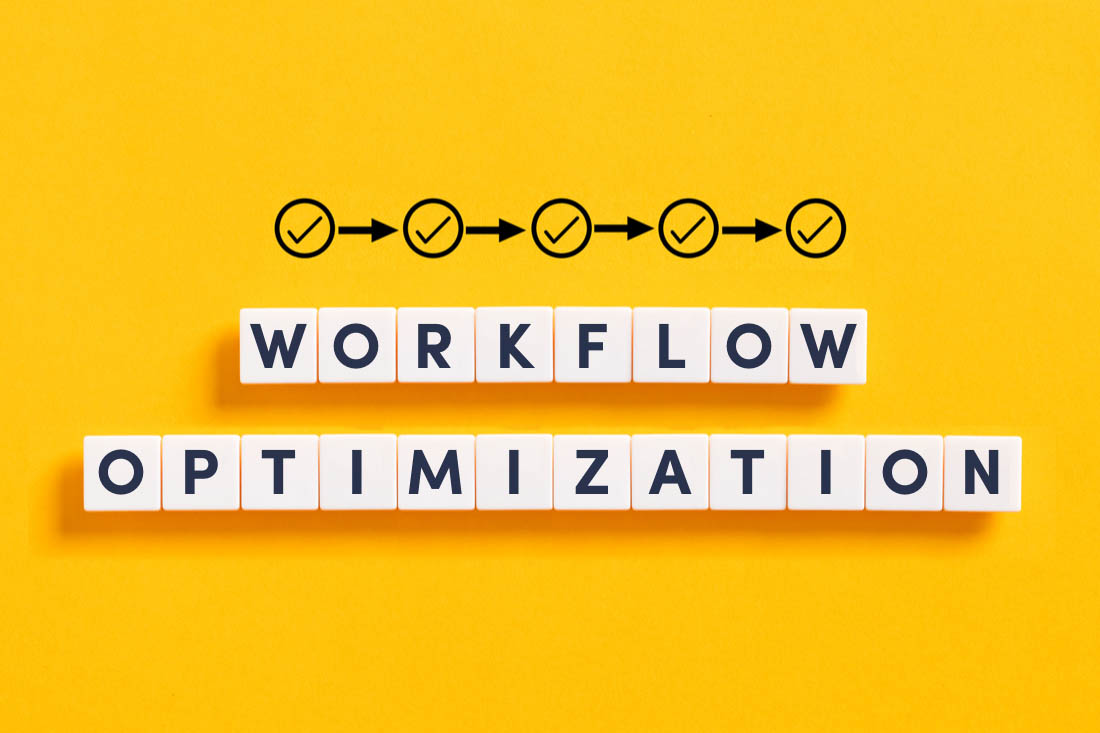Did you know businesses can lose up to $1.3 million a year due to inefficient workflows and manual processes? Most business leaders are so focused on business growth, they overlook the daily processes that fuel innovation in the first place.
If it’s been awhile since you conducted a workflow analysis, now’s the time. By identifying and fixing inefficiencies, you’ll quickly open the door to more productivity and lower costs — plus a more engaged workforce.
Let’s look at the process of workflow optimization and some strategies to help you do it.
What is workflow optimization?
Workflow optimization is the process of analyzing, streamlining and automating business workflows. It aims to eliminate unnecessary steps, reduce errors and make better use of technology. In short, optimizing workflows sets a strong foundation to help employees work as productively and efficiently as possible.
Moreover, workflow optimization is an ongoing journey — not a one-time project. As businesses evolve and market conditions change, workflows must adapt. For this reason, ongoing workflow optimization is a defining characteristic of companies with thriving cultures.
Workflow optimization benefits
Streamlined workflows aren’t just a nice-to-have — they’re critical to success. By minimizing time spent on repetitive tasks, you free employees to focus on improving products, services and customer relationships. The right workflow optimization techniques also open the door to:
- Enhanced productivity: Workflow optimization boosts productivity by eliminating time-consuming tasks and automating repetitive processes, allowing employees to focus on value-added activities.
- More collaboration: Clean workflows break down silos between teams to improve cross-departmental collaboration.
- Fewer errors: Workflow optimization reduces errors and improves the overall quality of work, leading to higher customer satisfaction and increased revenue.
- More job satisfaction: Efficient workflows mean work gets done faster, which has a positive impact on employee morale and job satisfaction.
- Higher engagement: When processes are streamlined and tasks are clearly defined, employees experience less frustration and confusion. This leads to a more engaged and motivated workforce.
Proven workflow optimization strategies to try today
Revamping your existing workflows may sound like a daunting task. But when more innovation and engagement are on the line, you can’t afford not to do it. And once you get into the habit of fine-tuning workflows, the amount of time it takes decreases significantly.
Here are eight proven workflow optimizing strategies to help you get started. Pick two or three for now, and bookmark this page so you can continue to add others.
- 1. Break down projects with Agile
- 2. Streamline steps with Kanban
- 3. Reduce waste with Lean
- 4. Workflow optimization with Kaizen
- 5. Resolve bottlenecks with TOC
- 6. Enhance processes with TQM
- 7. Redesign with BPR
- 8. Simplify workflows with 5S
1. Make large projects more manageable with the agile approach
The agile technique focuses on breaking down a large project into small, manageable pieces of work. Start by partitioning your overall project into a series of smaller projects, or “sprints.” Then, within each two- or three-week sprint, define and assign individual tasks.
The agile method typically relies on workflow automation software to create visual, step-by-step illustrations of each step — and to show how your team will flow from one item to the next. It’s ideal for workflows that change frequently and fast.
2. Make it easy to flow through steps with the Kanban system
Similar to the agile method, the Kanban system uses visual cues to prompt team members to take immediate action and keep workflows on track. It stems from a Japanese word that directly translates to “visual card.”
Start by using workflow management software to create a Kanban card for each task. Then arrange your cards into columns or “swimlanes.” As team members complete steps in your workflows, they move the corresponding card to the appropriate swimline. For example, the same single task might progress from “in progress” to “ready for review” to “ready for quality assurance” to “done.” This makes it easy to follow progress in real time.
3. Eliminate waste with the lean method
The goal of the lean method is exactly what the name implies — to keep workflows as clutter-free, or lean, as possible. It involves removing unnecessary steps and streamlining others. This helps reduce the amount of time employees spend on non-value-added activities, freeing them to focus on work that matters.
To use the lean method, simply look for wasteful practices. Some of the most common include frequent or ineffective meetings, data entry and repetitive tasks. Then take steps to streamline them — replace those extraneous meetings with email updates and find software to automate manual tasks.
4. Improve long-term workflows with the Kaizen concept
“Kaizen” refers to a Japanese concept for focusing on continuous, ongoing improvements. While the agile and lean methods focus primarily on how quickly individual projects progress, Kaizen addresses how efficiently work gets done over time.
With Kaizen, the long-term goal is to create a company culture where everyone is encouraged to fine-tune processes as a best practice. Over time, workflows improve as the result of constant, small tweaks. Start by inviting employees to look for opportunities to improve current workflows, and empower them to try different solutions.
5. Remove bottlenecks with the theory of constraints (TOC)
The Theory of Constraints is a workflow optimization strategy that helps you speed things up by finding and removing bottlenecks. Start by looking for the biggest limiting factor, or constraint, in your workflow. Then test different ways to remove it.
If it takes too long to collect feedback from multiple people, try reducing the number of reviewers. If a particular team consistently falls behind on providing approvals, look for a different department that can get to it faster. Or try adding a deadline, and let the team if you don’t hear from them by that date you’ll assume the step is automatically approved. Repeat this process for each bottleneck until your workflow is as seamless as possible.
6. Improve organization-wide workflows with total quality management (TQM)
Total quality management is a structured approach to improving workflows organization-wide. With roots in manufacturing, the TQM method holds all teams and individuals accountable for the final product or service. This is a good technique to use if you want to get granular — the goal of TQM is to continually identify, reduce and eliminate errors as customer demands change.
While there’s no one right way to apply TQM, the key is to involve all teams that contribute to the workflow — and ultimately, the final product or service it leads to. So if your engineering, sales and marketing teams regularly collaborate, you’d build a master plan for regularly evaluating each step for every team. When you discover a workflow component that’s no longer relevant or no longer works, adjust it. Then do this again and again to keep work flowing and ensure quality remains high.
7. Rebuild with business process improvement and reengineering
If you have a lot of improvements to make, it’s time to take a more involved approach. Two ways to do this are with the business process improvement (BPI) method and the business process reengineering (BPR) strategy.
With BPI, focus on identifying inefficient, error-prone components of your workflow. This approach works well if a few steps are slowing down an otherwise effective process. But if a lot of steps need to be revamped, BPR is the way to go. With this strategy, you redesign the entire workflow from scratch. Start by using your existing project management tools to conduct a thorough analysis of your current workflows. This will help reveal the biggest problem areas, allowing you to create a better flow from the ground up.
8. Make workflow management more manageable with the 5S method
If BPI and BPR sound too intense for right now, try the 5S method instead. This five-part methodology also focuses on creating uncluttered, streamlined workflows — but breaks it down into manageable components. Each one is named after a Japanese word.
The process starts with seiri, or sorting, to identify unnecessary steps in your process. Next comes seiton, which means to straighten or set in order. Then you move on to seisō, which refers to inspecting and perfecting each step until it “shines.” At this stage you create guidelines to standardize, or seiketsu, future workflows. Last comes shitsuke, where you focus on sustaining those changes over time.
How to optimize workflows for employees
The above strategies are all great ways to optimize existing workflows and build new ones. But how do you realistically put them into practice? The simplest, easiest way is to follow these five steps.
- Review goals: Do you need to completely revamp your existing workflows? Or is your goal to make your current setup even more efficient? Deciding your goals first will influence which strategies you try and how much time you’ll dedicate to workflow optimization.
- Analyze existing workflows: Whether you conduct surveys or interview team members, gathering intel on your current workflows is key. Don’t assume a particular step is causing problems — find out from people closest to the process what they experience. Then combine your findings into a short, easy-to-digest snapshot.
- Identify constraints: Many of the strategies above involve identifying bottlenecks and other problems. While your workflow analysis will reveal many of these, it’s important to dive deeper and ensure you don’t overlook others. This means more work at the outset, but the end result will be much more impactful.
- Document revised workflows: As you use your findings to fix workflows, document each new process. This will make it easier for other teams to follow your lead, and will help prevent the same problems from resurfacing again in the future.
- Make adjustments: Once you complete the steps above, put a plan in place for regularly reviewing and adjusting your documented process. It doesn’t have to be often — quarterly or bi-annually should do it — but should be set in stone. Then, when it’s time to review and adjust, look for opportunities to apply any strategies above you haven’t tried yet.
Analyze and optimize employee workflows with ActivTrak
Ready to optimize your workflows? ActivTrak’s software makes workflow optimization easy! More than 9,500 organizations use ActivTrak to automatically collect and analyze daily work activities, and to gain workforce insights you won’t find elsewhere.





